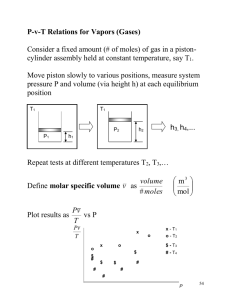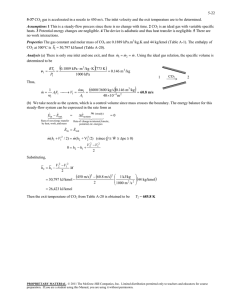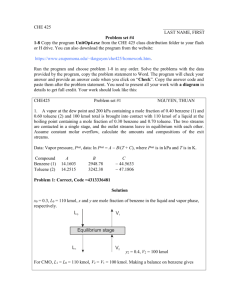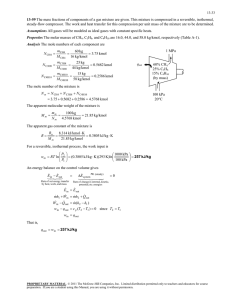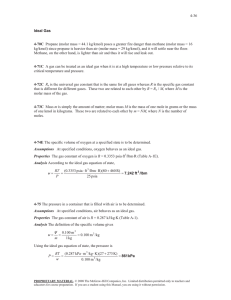Peng-Robinson Equation of State
advertisement
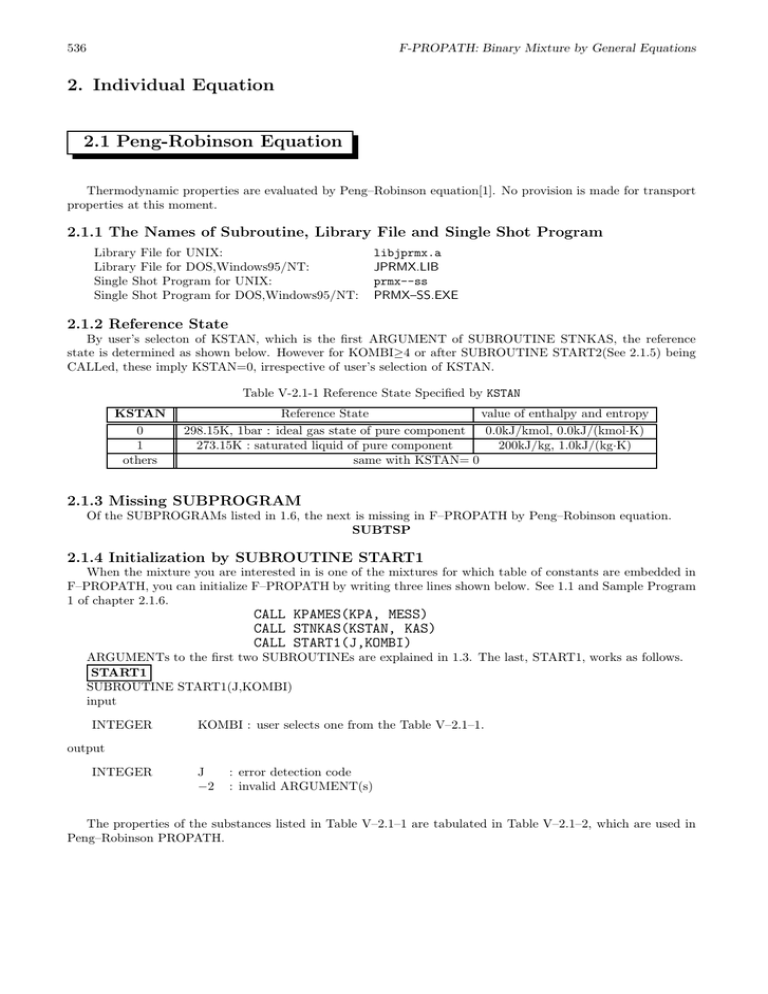
536 F-PROPATH: Binary Mixture by General Equations 2. Individual Equation 2.1 Peng-Robinson Equation Thermodynamic properties are evaluated by Peng–Robinson equation[1]. No provision is made for transport properties at this moment. 2.1.1 The Names of Subroutine, Library File and Single Shot Program Library File for UNIX: Library File for DOS,Windows95/NT: Single Shot Program for UNIX: Single Shot Program for DOS,Windows95/NT: libjprmx.a JPRMX.LIB prmx--ss PRMX–SS.EXE 2.1.2 Reference State By user’s selecton of KSTAN, which is the first ARGUMENT of SUBROUTINE STNKAS, the reference state is determined as shown below. However for KOMBI≥4 or after SUBROUTINE START2(See 2.1.5) being CALLed, these imply KSTAN=0, irrespective of user’s selection of KSTAN. Table V-2.1-1 Reference State Specified by KSTAN KSTAN 0 1 others Reference State value of enthalpy and entropy 298.15K, 1bar : ideal gas state of pure component 0.0kJ/kmol, 0.0kJ/(kmol·K) 273.15K : saturated liquid of pure component 200kJ/kg, 1.0kJ/(kg·K) same with KSTAN= 0 2.1.3 Missing SUBPROGRAM Of the SUBPROGRAMs listed in 1.6, the next is missing in F–PROPATH by Peng–Robinson equation. SUBTSP 2.1.4 Initialization by SUBROUTINE START1 When the mixture you are interested in is one of the mixtures for which table of constants are embedded in F–PROPATH, you can initialize F–PROPATH by writing three lines shown below. See 1.1 and Sample Program 1 of chapter 2.1.6. CALL KPAMES(KPA, MESS) CALL STNKAS(KSTAN, KAS) CALL START1(J,KOMBI) ARGUMENTs to the first two SUBROUTINEs are explained in 1.3. The last, START1, works as follows. START1 SUBROUTINE START1(J,KOMBI) input INTEGER KOMBI : user selects one from the Table V–2.1–1. output INTEGER J −2 : error detection code : invalid ARGUMENT(s) The properties of the substances listed in Table V–2.1–1 are tabulated in Table V–2.1–2, which are used in Peng–Robinson PROPATH. Peng-Robinson Equation 537 Table V-2.1-2 Combination of Substances Specified by KOMBI KOMBI 1 2 3 4 5 6 7 8 9 10 11 12 13 14 15 16 17 component 1 R22 R32 R32 CH4 CH4 CH4 CH4 CH4 CH4 CH4 CH4 CH4 CH4 CH4 CH4 CH4 O2 component 2 R123 R125 R134a C2 H4 C2 H6 C3 H6 C3 H8 i–C4 H10 n–C4 H10 i–C5 H12 n–C5 H12 n–C6 H14 C6 H6 C6 H12 n–C7 H16 n–C8 H18 CO2 interaction parameter 0.0 [2] 0.013 [3] -0.01816 [4] 0.022 [5] -0.003 [5] 0.033 [5] 0.016 [5] 0.026 [5] 0.019 [5] -0.006 [5] 0.026 [5] 0.040 [5] 0.055 [5] 0.039 [5] 0.035 [5] 0.050 [5] 0.09 [6] Table V-2.1-3 Fundamental Constants of Pure Components tabulated in Table V-2.1-2 substance R22 R123 R32 R125 R134a CH4 CO2 C2 H4 C2 H6 C3 H6 C3 H8 n–C4 H10 i–C4 H10 i–C5 H12 n–C5 H12 C6 H6 C6 H12 n–C6 H14 n–C7 H16 n–C8 H18 O2 M [kg/kmol] 86.468 152.931 52.024 120.022 102.030 16.043 44.010 28.054 30.070 42.081 44.096 58.123 58.123 72.150 72.150 78.114 84.161 86.177 100.204 114.231 31.999 Tc [K] 369.30 456.86 351.26 339.19 374.21 190.56 304.21 282.36 305.32 364.76 369.83 425.12 408.14 460.43 469.70 562.16 553.54 507.60 540.20 568.70 154.58 pc [MPa] 4.971 3.6655 5.778 3.631 4.056 4.5990 7.3830 5.0318 4.8720 4.6126 4.2480 3.7960 3.6480 3.3812 3.3700 4.8980 4.0748 3.0250 2.7400 2.4900 5.0430 vc [m3 /kmol] 0.1660 0.27500 0.12100 0.20983 0.19812 0.09860 0.09400 0.12907 0.14550 0.18100 0.20000 0.25500 0.26270 0.30583 0.31300 0.25894 0.30788 0.37100 0.42800 0.48600 0.07340 ω [-] 0.2192 0.2825 0.278 0.306 0.326 0.0115 0.2276 0.0852 0.0995 0.1424 0.1523 0.2002 0.1770 0.2275 0.2515 0.2108 0.2118 0.3013 0.3495 0.3996 0.0218 reference [7] [7] [3](Tc, pc, ω), [7](M, vc) [3](Tc, pc, ω), [7](M, vc) [4](Tc, pc, ω), [8](M, vc) [7] [7] [7] [7] [7] [7] [7] [7] [7] [7] [7] [7] [7] [7] [7] [7] 2.1.5 Initialization by SUBROUTINE START2 By the procedure described below, user can use F–PROPATH by Peng–Robinson equation for any mixture. However in that case a user has to transfer related constants of each component to F–PROPATH. They are molar mass, critical constants(temperature, pressure, volume), acentric factor, coefficients of isobaric specific heat equation at ideal gas state, and interaction parameter. A user has to write the lines shown below before he or she makes reference to any F–PROPATH by Peng– Robinson equation SUBPROGRAM. DIMENSION PR1(5),PR2(5),CP1(8),CP2(8) DATA STATEMENT for PR1,PR2,CP1,CP2 AKIJ=X 538 F-PROPATH: Binary Mixture by General Equations CALL KPAMES(KPA,MESS) CALL STNKAS(KSTAN,KAS) CALL START2(J,PR1,PR2,AKIJ,CP1,CP2) PR1 and PR2 are arrays to which a user transfers constants for component 1 and 2, respectively. CP1 and CP2 are arrays to which a user trasfers coefficients of isobaric specific heat equation for component 1 and 2, respectively. AKIJ is the interaction parameter defined in reference [1]. Elements of PR1 and PR2 mean what are shown below. PR1(1) PR1(2) PR1(3) PR1(4) PR1(5) : : : : : molar mass of component 1 [kg/kmol] critical temperature of component 1 [K] critical pressure of component 1 [Pa] critical volume of component 1 [m3 /kmol] acentric factor of component 1 [-] PR2(1) PR2(2) PR2(3) PR2(4) PR2(5) : : : : : molar mass of component 2 [kg/kmol] critical temperature of component 2 [K] critical pressure of component 2 [Pa] critical volume of component 2 [m3 /kmol] acentric factor of component 2 [-] A user is allowed to use one of the following two equation of isobaric specific heat at ideal gas state (T : temperature [K]). (1) CP[J/(kmol·K)] = A + B[(C/T ) sinh(C/T )]2 + D[(E/T ) cosh(E/T )] , CP*(1) = 1.0 (2) CP[J/(kmol·K)] = A + BT + CT 2 + DT 3 + ET 4 , CP*(1) = 2.0 Elements of CP1 and CP2 mean what are shown below. CP1(1) CP1(2) CP1(3) CP1(4) CP1(5) CP1(6) CP1(7) CP1(8) : : : : : : : : number of equation 1.0 or 2.0 for component 1. value of A for component 1 value of B for component 1 value of C for component 1 value of D for component 1 value of E for component 1 lower valid bound of the equation [K] upper valid bound of the equation [K] CP2(1) CP2(2) CP2(3) CP2(4) CP2(5) CP2(6) CP2(7) CP2(8) : : : : : : : : number of equation 1.0 or 2.0 for component 2. value of A for component 2 value of B for component 2 value of C for component 2 value of D for component 2 value of E for component 2 lower valid bound of the equation [K] upper valid bound of the equation [K] J is the error detection code. When PR1(2)>PR2(2), Tc1 >Tc2 , exchange between component 1 and 2 will occur and J= −1 will be returned. For other invalid ARGUMENT(s), J= −2 will occur. 2.1.6 Example of User’s PROGRAM UNIT Sample Program 1 PROGRAM EX1 C------------------------------------------------------------------C Peng-Robinson Equation C For R22-R123 mixture(KOMBI=1),this program calculates C temperature at buble point from Z=0.0 TO 1.0[kmol R22/kmol] at C every 0.1[kmol R22/kmol]. Peng-Robinson Equation C------------------------------------------------------------------C C----------------------------------------------C T=[deg],P=[bar],amount of substance=[kmol] C standard state=(298.15[K],1[bar]) C----------------------------------------------CALL KPAMES(1,1) CALL STNKAS(0,0) CALL START1(J,1) C C----------------------------------------C Calculation of pressure at buble point C using TBP and output results. C----------------------------------------P=1.0 DO 10 I=0,10 Z=FLOAT(I)*0.1 T=TBP(P,Z) WRITE(*,*) Z,T 10 CONTINUE STOP END C C C result C C 0.000000E+00 27.395430 C 1.000000E-01 7.765078 C 2.000000E-01 -5.087575 C 3.000000E-01 -14.011260 C 4.000000E-01 -20.619320 C 5.000000E-01 -25.767130 C 6.000000E-01 -29.933280 C 7.000000E-01 -33.404360 C 8.000000E-01 -36.362870 C 9.000000E-01 -38.931340 C 1.000000 -41.196050 Sample Program 2 PROGRAM EX2 C-----------------------------------------------------------------C Peng-Robinson Equation C For methane-ethylene mixture(KOMBI=4),this program calculates C VLE properties at P=1.0[bar] and T=150[K]. C-----------------------------------------------------------------C C---------------------------------------C T=[K],P=[Pa] C standard state=(298.15[K],1[bar]) C amount of substance=[kmol] C---------------------------------------CALL KPAMES(0,1) CALL STNKAS(0,0) C C-------------------------C Execution START1. C-------------------------CALL START1(J,4) C C---------------------------------------------------------C Calculation of VLE properties on saturated state C and output results. C---------------------------------------------------------P=1.0E5 T=150.0 539 540 F-PROPATH: Binary Mixture by General Equations CALL SUBXY(J,T,P,X,Y,VL,VV,HL,HV,SL,SV) HL=HL*1.0E-6 HV=HV*1.0E-6 SL=SL*1.0E-3 SV=SV*1.0E-3 WRITE(*,*) ’ X[KMOL CH4/KMOL]=’,X, ’ Y[KMOL CH4/KMOL]=’,Y WRITE(*,*) ’ VL[M^3/KMOL] =’,VL,’ VV[M^3/KMOL] =’,VV WRITE(*,*) ’ HL[MJ/KMOL] =’,HL,’ HV[MJ/KMOL] =’,HV WRITE(*,*) ’ SL[KJ/KMOL] =’,SL,’ SV[KJ/KMOL] =’,SV STOP END C C C....result C C X[KMOL CH4/KMOL]= C VL[M^3/KMOL] = C HL[MJ/KMOL] = C SL[KJ/KMOL] = 5.313301E-02 4.313929E-02 -19.099360 -105.360700 Y[KMOL CH4/KMOL]= VV[M^3/KMOL] = HV[MJ/KMOL] = SV[KJ/KMOL] = 7.212105E-01 12.211230 -5.234992 -19.152850 Sample Program 3 PROGRAM EX3 C C----------------------------------------------------------------C Peng-Robinson Equation C For ethane-propane mixture,this program calculates property C at buble point at T=250[K] and Z=0.5[kmol C2H6/kmol]. C----------------------------------------------------------------C C--------------------------------------------C Definition of array PR1,PR2,CP1 and CP2. C--------------------------------------------DIMENSION PR1(5),PR2(5),CP1(8),CP2(8) C C---------------------------------------C T=[K],P=[Pa],quantity=[kmol] C standard state=(298.15[K],1[bar]) C---------------------------------------CALL KPAMES(0,1) CALL STNKAS(0,0) C C---------------------------------------------------------------------------C Putting fundamental constants into PR1 and PR2 using DATA STATEMENT. C DATA(PR1(I),I=1,5)/MW1[KG/KMOL],TC1[K],PC1[PA],VC1[M^3/KMOL],OMEGA1[-]/ C DATA(PR2(I),I=1,5)/MW2[KG/KMOL],TC2[K],PC2[PA],VC2[M^3/KMOL],OMEGA2[-]/ C---------------------------------------------------------------------------DATA(PR1(I),I=1,5)/ 30.070, 305.42, 4.8801D6, 0.14792, 0.0990/ DATA(PR2(I),I=1,5)/ 44.096, 369.82, 4.2492D6, 0.20288, 0.1518/ C C---------------------------------------------------------------------------C Putting isobaric heat capacity at ideal gas state into CP1 and CP2 C using DATA STATEMENT. C DATA(CP1(I),I=1,8)/EQUATION NUMBER,A,B,C,D,E,TMIN[K],TMAX[K]/ C DATA(CP2(I),I=1,8)/EQUATION NUMBER,A,B,C,D,E,TMIN[K],TMAX[K]/ C---------------------------------------------------------------------------DATA(CP1(I),I=1,8) & /1.0, 3.5650E4, 1.35200E5, 1.4300E3, 6.1800E4, 6.1200E2, & 100.0, 1500.0 / DATA(CP2(I),I=1,8) & /1.0, 4.4000E4, 1.93800E5, 1.3690E3, 9.8000E4, 5.8300E2, & 100.0, 1500.0 / C C-----------------------------------------C Setting interaction parametar AKIJ. C------------------------------------------ Peng-Robinson Equation 541 AKIJ=0.001 C C-------------------------C Execution START2. C-------------------------CALL START2(J,PR1,PR2,AKIJ,CP1,CP2) C C-------------------------------------------C Calculation of properties at buble point C using SUBPB and output results. C-------------------------------------------T=250.0 Z=0.5 CALL SUBPB(J,T,P,Z,V,H,S) P=P*1.0E-6 H=H*1.0E-6 S=S*1.0E-3 WRITE(*,*) ’ P[MPA] =’,P WRITE(*,*) ’ V[M^3/KMOL] =’,V WRITE(*,*) ’ H[MJ/KMOL] =’,H WRITE(*,*) ’ S[KJ/KMOL] =’,S STOP END C C C....result C C P[MPA] = 7.229552E-01 C V[M^3/KMOL] = 6.797910E-02 C H[MJ/KMOL] = -18.242270 C S[KJ/KMOL] = -79.194690 Sample Program 4 PROGRAM EX4 C----------------------------------------C Peng-Robinson Equation C For R32-R125 mixture (KOMBI=2), C this program execute only MKTABL. C----------------------------------------CALL MKTABL(J,2) STOP END C C C You do not need to CALL SUBROUTINE C KPAMES, STNKAS and START1 before C CALLing MKTABL C C result C C FUNDAMENTAL CONSTANTS C C MOLECULAR FORMULA C RELATIVE MOLECULAR MASS [KG/KMOL] C GAS CONSTANT [J/(KG*K)] C CRITICAL TEMPERATURE [K] C CRITICAL PRESSURE [MPA] C CRITICAL VOLUME [M^3/KMOL] C ACENTRIC FACTOR [-] C INTERACTION PATAMETER [-] C C C C R32 CH2F2 52.024 159.821 351.60 5.8302 .121000 .2763 R125 CF3CHF2 120.020 69.276 339.40 3.6310 .209830 .3060 .0130 IDEAL GAS HEAT CAPACITY EQUATION NUMBER A R32 1 .340600E+05 R125 2 .236022E+05 542 C C C C C C F-PROPATH: Binary Mixture by General Equations B C D E LOW TEMPERATURE LIMIT [K] HIGH TEMPERATURE LIMIT [K] .714400E+05 .142200E+04 .394000E+05 .677000E+03 100.0 1500.0 .283723E+03 -.123028E+00 -.567252E-04 .000000E+00 150.0 500.0 2.1.7 Sample Output of Single Shot Program ======================================================================== | Single Shot Program for Peng-Robinson Equation, | | an Application Program by F-PROPATH Ver.9.1 | | Thermophysical Properties of Binary Mixtures | |----------------------------------------------------------------------| | ## First Menu ## | | No. Current | | 1 --> Go to Second Menu | | 2 --> Select Mixture (Component1 - Component2) | | [ R32 - R125 ] | | 3 --> Read Help | | 4 --> Set Logfile [OFF] | | 0 --> Quit | ======================================================================== Input No. 3 This is help for this program (PRMX-SS.EXE) Nomenclature ==== First Charactor ==== H : Enthalpy P : Pressure S : Entropy T : Temperature V : Volume X : Component1 Composition of Liquid Y : Component1 Composition of Vapor Z : Total Composition of Component1 ==== Second Charactor ==== B : Bubble Point D : Dew Point L : Liquid V : Vapor ----- Hit RETURN Key ----======================================================================== | Single Shot Program for Peng-Robinson Equation, | | an Application Program by F-PROPATH Ver.9.1 | | Thermophysical Properties of Binary Mixtures | |----------------------------------------------------------------------| | ## First Menu ## | | No. Current | | 1 --> Go to Second Menu | | 2 --> Select Mixture (Component1 - Component2) | | [ R32 - R125 ] | | 3 --> Read Help | | 4 --> Set Logfile [OFF] | | 0 --> Quit | ======================================================================== Input No. 4 1: Logfile ON 2: Logfile OFF Peng-Robinson Equation Input No. 1 Input Filename PRMIX.LOG ======================================================================== | Single Shot Program for Peng-Robinson Equation, | | an Application Program by F-PROPATH Ver.9.1 | | Thermophysical Properties of Binary Mixtures | |----------------------------------------------------------------------| | ## First Menu ## | | No. Current | | 1 --> Go to Second Menu | | 2 --> Select Mixture (Component1 - Component2) | | [ R32 - R125 ] | | 3 --> Read Help | | 4 --> Set Logfile [ON] PRMIX.LOG | | 0 --> Quit | ======================================================================== Input No. 2 ===================================== | No.| Component1 - Component2 | |----|------------------------------| | 1 | [ R22 - R123 ] | | 2 | [ R32 - R125 ] | | 3 | [ R32 - R134a ] | | 4 | [ CH4 - C2H4 ] | | 5 | [ CH4 - C2H6 ] | | 6 | [ CH4 - C3H6 ] | | 7 | [ CH4 - C3H8 ] | | 8 | [ CH4 - i-C4H10 ] | | 9 | [ CH4 - n-C4H10 ] | | 10 | [ CH4 - i-C5H12 ] | | 11 | [ CH4 - n-C5H12 ] | | 12 | [ CH4 - C6H14(n-Hexane) ] | | 13 | [ CH4 - C6H6(Benzene) ] | | 14 | [ CH4 - C6H12(Cyclohexane) ] | | 15 | [ CH4 - C7H16(n-Heptan) ] | | 16 | [ CH4 - C8H18(n-Octane) ] | ===================================== Input No. 1 ======================================================================== | Single Shot Program for Peng-Robinson Equation, | | an Application Program by F-PROPATH Ver.9.1 | | Thermophysical Properties of Binary Mixtures | |----------------------------------------------------------------------| | ## First Menu ## | | No. Current | | 1 --> Go to Second Menu | | 2 --> Select Mixture (Component1 - Component2) | | [ R22 - R123 ] | | 3 --> Read Help | | 4 --> Set Logfile [ON] PRMIX.LOG | | 0 --> Quit | ======================================================================== Input No. 1 =============================================================== | ## Second Menu ## | | <Single and Two Phase States> | | No. Input Output | | 1 --(P,T,Z)--> H HL HV S SL SV V VL VV X Y QUALITY | | 2 --(P,Z,H)--> T HL HV S SL SV V VL VV X Y QUALITY | | 3 --(P,Z,S)--> T H HL HV SL SV V VL VV X Y QUALITY | | 4 --(P,Z,V)--> T H HL HV S SL SV VL VV X Y QUALITY | |-------------------------------------------------------------| | <Two Phase State> | | 5 --(P,Z)----> X=Z : TB HB SB VB Y=Z : TD HD SD VD | | 6 --(T,Z)----> X=Z : PB HB SB VB Y=Z : PD HD SD VD | | 7 --(P,T)----> Coexisting Phases: X Y HL HV SL SV VL VV | 543 544 F-PROPATH: Binary Mixture by General Equations |-------------------------------------------------------------| | 8 -----------> Fundamental Constants | | 9 -----------> Conversion of Composition and Relative | | Molcular Mass of Mixture | |10 -----------> Change System of Unit, and Standard Values of| | Enthalpy and Entropy | |99 -----------> Return to First Menu | | 0 -----------> Quit | =============================================================== Input No. 10 ======================================================= No. current ======================================================= 1 --> Pressure and Temperature [ Pa, K] 2 --> Amount of Substance [kmol] 3 --> Standard Values of h and s [1] Ideal Gas State 0 --> Return to Second Menu ======================================================= Input No. 1 =============================== No. <Pressure> <Temperature> =============================== 1 --> Pa K 2 --> bar C 3 --> bar K 4 --> Pa C =============================== Input No. 1 ======================================================= No. current ======================================================= 1 --> Pressure and Temperature [ Pa, K] 2 --> Amount of Substance [kmol] 3 --> Standard Values of h and s [1] Ideal Gas State 0 --> Return to Second Menu ======================================================= Input No. 2 =========================== No. Amount of Substance 1 --> kmol 2 --> kg =========================== Input No. 1 ======================================================= No. current ======================================================= 1 --> Pressure and Temperature [ Pa, K] 2 --> Amount of Substance [kmol] 3 --> Standard Values of h and s [2] IIR 0 --> Return to Second Menu ======================================================= Input No. 3 ================================================ No. Standard States and Values of h and s 1 --> Ideal Gas State of Pure Components h=0.0[kJ/kg], s=0.0[kJ/(kg*K)] Pure Ideal Gases at 0[C], 1.0[bar] 2 --> Convention of International Institute of Refrigeration(IIR): Peng-Robinson Equation h=200[kJ/kg], s=1.0[kJ/(kg*K)] Saturated Pure Liquids at 0[C] ================================================ Input No. 1 ======================================================= No. current ======================================================= 1 --> Pressure and Temperature [ Pa, K] 2 --> Amount of Substance [kmol] 3 --> Standard Values of h and s [1] Ideal Gas State 0 --> Return to Second Menu ======================================================= Input No. 0 =============================================================== | ## Second Menu ## | contents not shown =============================================================== Input No. 9 ================================================================== Conversion of Composition and Relative Molecular Mass of Mixture ================================================================== 1: [kmol/kmol] --> [kg/kg] and Relative Molecular Mass of Mixture 2: [kg/kg] --> [kmol/kmol] and Relative Molecular Mass of Mixture 0: Return to Second Menu Input No. 1 Input Z[kmol/kmol] 0.5 Z = .50000000[kmol/kmol] Z = .36118780[kg/kg] Relative Molecular Mass of Mixture = 119.69950000[kg/kmol] Relative Molecular Mass of [ R22 ] 86.46800000[kg/kmol] Relative Molecular Mass of [ R123 ] 152.93100000[kg/kmol] 1: [kmol/kmol] --> [kg/kg] and Relative Molecular Mass of Mixture 2: [kg/kg] --> [kmol/kmol] and Relative Molecular Mass of Mixture 0: Return to Second Menu Input No. 2 Input Z[kg/kg] 0.5 Z = .50000000[kg/kg] Z = .63881220[kmol/kmol] Relative Molecular Mass of Mixture = 110.47360000[kg/kmol] Relative Molecular Mass of [ R22 ] 86.46800000[kg/kmol] Relative Molecular Mass of [ R123 ] 152.93100000[kg/kmol] 1: [kmol/kmol] --> [kg/kg] and Relative Molecular Mass of Mixture 2: [kg/kg] --> [kmol/kmol] and Relative Molecular Mass of Mixture 0: Return to Second Menu Input No. 0 =============================================================== | ## Second Menu ## | contents not shown =============================================================== Input No. 8 545 546 ======================= Fundamental Constants ======================= <Constants> Relative Molecular Mass Gas Constants Critical Temperature Critical Pressure Critical Volume Acentric Factor F-PROPATH: Binary Mixture by General Equations [ R22 ] 86.46800000 96.15707000 369.30000000 96.14999000 49.71000000 .16861500E+00 .19500280E-02 .21920000E+00 [ R123 ] 152.93100000 54.36772000 456.86000000 183.71000000 36.66000000 .27527600E+00 .18000010E-02 .28160000E+00 [kg/kmol] [J/(kg*K)] [K] [C] [bar] [m**3/kmol] [m**3/kg] [-] ----- Hit RETURN Key ----=============================================================== | ## Second Menu ## | contents not shown =============================================================== Input No. 1 ====================================== (P,T,Z) --> H, S, V, QUALITY X, HL, SL, VL Y, HV, SV, VV ====================================== Input P[Pa] (P=0 : Second Menu) 1000000.0 Input T[K] 300.0 Input Z[kmol/kmol] 0.5 T = 300.00000000[K] P = 1000.00000000[kPa] Z = .50000000[kmol/kmol] H = -21618.98000000[kJ/kmol] S = -65.95230000[kJ/(kmol*K)]V = .86610340E-01[m**3/kmol] Liquid Region Input P[Pa] (P=0 : Second Menu) 100000.0 Input T[K] 250.0 Input Z[kmol/kmol] 0.7 T = 250.00000000[K] P = 100.00000000[kPa] Z = .70000000[kmol/kmol] H = -15176.73000000[kJ/kmol] S = -51.98681000[kJ/(kmol*K)]V = .10478000E+02[m**3/kmol] X = .44631380[kmol/kmol] Y = .93874230[kmol/kmol] HL = -28246.19000000[kJ/kmol] HV = -2877.16200000[kJ/kmol] SL = -98.26443000[kJ/(kmol*K)]SV = -8.43526600[kJ/(kmol*K)] VL = .80284680E-01[m**3/kmol] VV = .20263210E+02[m**3/kmol] QUALITY = .51517370[kmol/kmol] Input P[Pa] (P=0 : Second Menu) 0 =============================================================== | ## Second Menu ## | contents not shown =============================================================== Input No. 2 ====================================== (P,Z,H) --> T, S, V, QUALITY X, HL, SL, VL Y, HV, SV, VV ====================================== Input P[Pa] (P=0 : Second Menu) 1000000.0 Input Z[kmol/kmol] 0.5 Peng-Robinson Equation Input H[J/kmol] -21618000.0 T = 300.00770000[K] P Z = .50000000[kmol/kmol] H S = -65.94904000[kJ/(kmol*K)]V Liquid Region 547 = = = 1000.00000000[kPa] -21618.00000000[kJ/kmol] .86611980E-01[m**3/kmol] Input P[Pa] (P=0 : Second Menu) 0 =============================================================== | ## Second Menu ## | contents not shown =============================================================== Input No. 3 ====================================== (P,Z,S) --> T, H, V, QUALITY X, HL, SL, VL Y, HV, SV, VV ====================================== Input P[Pa] (P=0 : Second Menu) 1000000.0 Input Z[kmol/kmol] 0.5 Input S[J/(kmol*K)] -65952.0 T = 300.00070000[K] P = 1000.00000000[kPa] Z = .50000000[kmol/kmol] H = -21618.89000000[kJ/kmol] S = -65.95200000[kJ/(kmol*K)]V = .86610490E-01[m**3/kmol] Liquid Region Input P[Pa] (P=0 : Second Menu) 0 =============================================================== | ## Second Menu ## | contents not shown =============================================================== Input No. 4 ======================================== (P,Z,V) --> T, H, S, QUALITY X, HL, SL, VL Y, HV, SV, VV ======================================== Input P[Pa] (P=0 : Second Menu) 1000000.0 Input Z[kmol/kmol] 0.5 Input V[m**3/kmol] 0.08661034 T = 300.00000000[K] P = 1000.00000000[kPa] Z = .50000000[kmol/kmol] H = -21618.97000000[kJ/kmol] S = -65.95229000[kJ/(kmol*K)]V = .86610340E-01[m**3/kmol] Liquid Region Input P[Pa] (P=0 : Second Menu) 0 =============================================================== | ## Second Menu ## | contents not shown =============================================================== Input No. 5 =============================================== (P,Z) --> X=Z : TB, HB, SB, VB Y=Z : TD, HD, SD, VD =============================================== Input P[Pa] (P=0 : Second Menu) 548 100000.0 Input Z[kmol/kmol] 0.5 P = 100.00000000[kPa] Z TB = 247.38290000[K] TD HB = -27952.04000000[kJ/kmol] HD SB = -98.41191000[kJ/(kmol*K)]SD VB = .78221300E-01[m**3/kmol] VD F-PROPATH: Binary Mixture by General Equations = = = = = .50000000[kmol/kmol] 284.15500000[K] -1276.68500000[kJ/kmol] 1.58987600[kJ/(kmol*K)] .22974330E+02[m**3/kmol] Input P[Pa] (P=0 : Second Menu) 0 =============================================================== | ## Second Menu ## | contents not shown =============================================================== Input No. 6 =============================================== (T,Z) --> X=Z : PB, HB, SB, VB Y=Z : PD, HD, SD, VD =============================================== Input Z[kmol/kmol] (Z < 0 : Second Menu) 0.5 Input T[K] 247.0 T = 247.00000000[K] Z = .50000000[kmol/kmol] PB = 98.46436000[kPa] PD = 17.06069000[kPa] HB = -27995.27000000[kJ/kmol] HD = -3909.78100000[kJ/kmol] SB = -98.65056000[kJ/(kmol*K)]SD = -1.19786100[kJ/(kmol*K)] VB = .78173880E-01[m**3/kmol] VD = .11956650E+03[m**3/kmol] Input Z[kmol/kmol] (Z < 0 : Second Menu) -1 =============================================================== | ## Second Menu ## | contents not shown =============================================================== Input No. 7 ============================================== (P,T) --> Coexisting Phases X, HL, SL, VL Y, HV, SV, VV ============================================== Input P[Pa] (P=0 : Second Menu) 100000.0 Input T[K] 250.0 T = 250.00000000[K] P = 100.00000000[kPa] X = .44631380[kmol/kmol] Y = .93874230[kmol/kmol] HL = -28246.19000000[kJ/kmol] HV = -2877.16200000[kJ/kmol] SL = -98.26443000[kJ/(kmol*K)]SV = -8.43526600[kJ/(kmol*K)] VL = .80284680E-01[m**3/kmol] VV = .20263210E+02[m**3/kmol] Input P[Pa] (P=0 : Second Menu) 0 =============================================================== | ## Second Menu ## | contents not shown =============================================================== Input No. 99 ======================================================================== | Single Shot Program for Peng-Robinson Equation, | | an Application Program by F-PROPATH Ver.9.1 | | Thermophysical Properties of Binary Mixtures | |----------------------------------------------------------------------| | ## First Menu ## | | No. Current | Peng-Robinson Equation 549 | 1 --> Go to Second Menu | | 2 --> Select Mixture (Component1 - Component2) | | [ R22 - R123 ] | | 3 --> Read Help | | 4 --> Set Logfile [ON] PRMIX.LOG | | 0 --> Quit | ======================================================================== Input No. 0 ***** See You Again ! ***** Stop - Program terminated. References [1] D. Y. Peng and D. B. Robinson, A New Two–Constant Equation of State, Ind. Eng. Chem., Fundam., Vol.15, No.1, 1976. [2] T. Takagi, Kyoto Institute of Technology, private communication. [3] M. Fukushima, Prediction of Thermodynamic Properties for non–Azeotropic Refrigerant Mixtures (in Japanese), The Fourteenth Japan Symposium on Thermophysical Properties, (1993). [4] Y. Sumida, N. Tanaka, H. Iijima and F. Matsuoka, Simulation of a Vapor Compression Cycle with Refrigerant Mixtures (in Japanese), The Fourteenth Japan Symposium on Thermophysical Properties, (1993). [5] S. I. Sandler, Chemical and Engineering Thermodynamics, Wiley Series in Chemical Engineering, (1989), pp.319. [6] Uenishi et.al. [7] T. E. Daubert and R. P. Dannar, Physical and Thermodynamics Properties of Pure Chemicals: Data Complilation. Taylor &Francis, (1989). [8] Japanese Association of Refrigeration and Japan Flon Gas Association, Thermophysical Properties of Environmentally Acceptable Fluorocarbons HFC–134a and HCFC–123 (in Japanese), (1990).


